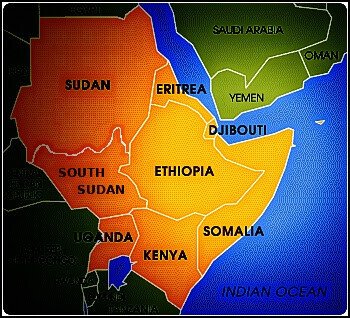Yonas Biru, PhD
I. Executive Summary
When it comes to facing a problem head-on, there is the proverbial ostrich that buries its head in the sand and there is PM Abiy Ahmed who turns attention to something else. True to his character, when the Orthodox Church conflict reached a point of national crisis, the PM ran out of town and released a picture with TPLF leaders to show he is in control and to give the media talking points away from the real crisis.
The PM is being tossed around by the waves of turbulence caused by Oromo extremist forces, including high-level officials in his own party. The crisis can be summarized in one line: በትረ መንግስት በእጁ ይዞ እና በመንበረ-ሥልጣን ዙፋን ላይ ተቀምጦ በራሱ ላይ መሸፈት የሚያምረው የኦሮሞ ሃይል ተነስቷል.
My command of the English language will not allow me to translate the line in a way that does justice to it. In a nutshell it means “The Oromo elite that sits at the apex of the political power structure and controls the levers of power is rebelling against itself.” Sadly, a mind that has been stuck in 50 years of grievance politics cannot unlearn its reflexive behavior that is primed to rebel.
The question that imposes itself on us is: Why did the Orthodox splinter group took a bold action at this juncture? Since the Church conflict has been ongoing for some time, the timing of the splinter group’s action is a marker of trigger events. Understanding this dynamic is critical to understand how we got where we are and how to get out of it.
One thing is for certain. By the time, the Tigrayan Liberation People’s Front (TPLF) came to power, the Tigrayan tribal politics had a well-developed and articulated goal that was strategically implemented. In contrast, the Oromo tribal politics has many heads and souls. It lacks strategy and what happens is determined by accident and chance.
As I have noted in an earlier article titled “The Accidental Rise and the Foreseeable Fall of Abiy Ahmed in the Land of Two Shenes”, two conflict centers have emerged after the fall of TPLF. The first is between Amhara and Oromo extremist groups – I call them Amhara-Shene and Oromo-Shene. The second is within Oromo political forces.
The conflict between the two Shenes has been raging in full earnest for nearly three years. Both see the PM as their primary enemy and channel their wrath against each other through him. Using him as a transmission line and converter station has allowed them to weaponize their animosity to each other as a national conflict. This has increasingly weakened the PM, and tilted the balance of power within the Oromo tribal forces in favor of his adversaries, without strengthening the Amhara power base.
The conflict within the Oromo landscape involves three different groups: Pan-Ethiopianist Oromos led by the PM, secessionist forces, champions of hegemonic Oromia within Ethiopia. The third group includes a shadow government within the Oromo wing of the Prosperity Party (PP-Oromo).
The dynamics of these two conflict centers have all but stripped the PM of the levers of power. His recent engagement with the TPLF that has refused to fully disarm and relinquish power as per the Pretoria agreement has signaled two things. The first signal is that he is powerless. The second is that he is not governed by principle, and he would do anything to stay in power. When seen from this perspective, the timing of the splinter Orthodox group’s bold action is both strategic and political. They acted because they believed the Oromo tribal land is his only lifeline and he will not act against them.
By forces of circumstances, Shene-Oromo that was a small group of ragtag Oromo Liberation Army (OLA) has progressively grown to a force of national significance as more Oromo tribalist forces threw their support behind it. With the PM all but incapacitated, the contention has been between Oromo Shene and the PP-Oromo shadow government.
The bold assault against the Ethiopian Orthodox Church has given Shene-Oromo strategic advantage against both the PM and the PP-Oromo shadow government. The PP-Oromo shadow government that has been supporting Shene-Oromo as an insurance policy against the PM’s reform agenda has found itself dwarfed by it.
Ethiopia is left naked without a leader and credible opposition against emboldened Oromo tribal groups that are increasingly morphing into the body and spirit of Shene-Oromo politics.
On the bright side, there is a silver lining in the gathering dark clouds. The fact that the PM is hiding in some distant land and the Oromo tribal government is aligning itself with the splinter Orthodox group has created a completely new dynamic that will unravel the Oromo tribal politics. The crisis will break the political apathy of the silent majority both inside and outside of the Oromo tribal land. Grownups will rise to take charge as Oromo elders have done to disassociate the Oromo youth from Jawar Mohammed toward the end of 2019 and the beginning of 2020.
My confidence that was expressed last week is further inspired by the Orthodox Church that has shown its centuries old tradition of wisdom and judgment. Its leaders have displayed mastery of strategic thinking and leadership in framing the agenda and managing the narrative. Their response to the PM’s speech has schooled the young PM the art and science of public relations.
A clarion call must be made by the Patriarch of the Orthodox Church to prohibit extremist forces from leveraging the crisis as a tool for political ends. The Church’s followers and supporters must stand guard to push back against political forces who wish to hijack the protest process. The Church must provide a list of slogans and protest banners for national and international rallies. Every speech that is delivered at rallies at home and abroad must be consistent and approved by the Church.
The purpose of this article is to show that the current crisis should not surprise us. It did not happen by accident. It happened by a slow-motion process. We will not exit from it until we understand the process that brought us here. This requires understanding the sources of the spiraling conflict and a sober discussion to build consensus. Let us start with the man at the helm of the political power structure.
II. Abiy-Ahmed: An Ordinary Man Drowning in an Extraordinary Turbulence
Before we judge the PM’s performance, we need to understand that governing an ungovernable society is no small feat. From the get-go, Amhara and Oromo extremists started pulling him to their extreme positions, denying him a space to govern from the center of the political spectrum.
On the one end, the likes of Shaleka Dawit want the PM to “abolish the constitution, dissolve parliament, abandon the ethnic agenda, and lead a transitional government by decree.” On the other end, Team Jawar Mohammed warned him “Ethnic federalism engrained in the current constitution is here to stay. It’s not up for discussion, let alone negotiation.”
These are Ivy League educated souls whose understanding of democratic governance is either ruling by decree or outlawing political discussions and negotiation. The story of the PM is one of reconciling such diametrically opposing, irreconcilably positioned, and deeply entrenched political culture of helplessly hermitized (Dawit) and permanently tribalized (Jawar) political activists. Illiterate peasants who stayed in line for hours to vote for their leaders appreciate democracy more than their Ivy-League educated counterparts.
Soon after he took office, the PM became a target of Oromo extremists for praising Emperor Menilik. “አፄ ምኒልክ ኢትዮጵያን ከወረራ በመከላከልና ቴክኖሎጂ በማስገባት ኢትዮጵያን ያስረከቡን ታላቅ መሪ ናቸው.” He was declared the enemy of Oromo when he affirmed that Ethiopia’s geographic proper and sovereign status are “not up for negotiation.”
Speaking of the PM’s betrayal of the Oromo, Milkessa M. Gemechu, a former member of the Central Committee of the Oromo Democratic Party (who is now in exile) wrote in Foreign Policy Magazine: “Not even one year into his premiership, he was openly regarded as a traitor in Oromia.”
Milkessa accused the PM of: (1) purging “hardcore Oromo nationalists from any role in his government at federal, regional, and local government levels”; (2) demonizing the Qeerroo as an “ungovernable pestilence that must be dealt with as soon as possible”; and (3) shifting the Oromo Democratic Party (ODP) “dramatically toward the public dominance of Ethiopian nationalists who are organized around Amharic language and culture, the Ethiopian Coptic Orthodox Church, and those who support a return to an overtly centralized unitarist government.”
On the other hand, Amhara extremists see him as the “enemy of Ethiopia and genocider of Amhara.” One thing common between extremist Oromo and Amhara forces is that they see only through the prism of a devout friend or a biblical foe. Both see the Prime Minister as a biblical foe. They both use him as a transmission line to wage a war against each other.
Whether the PM is an Ethiopianist, a softer version of Oromized Ethiopia, or an opportunist who would go with what he believed will keep him in power longer is debatable among rational observers. But what has dominated the political discourse is whether he is part of the Oromo-Shene anti-Ethiopia strategy bent on weakening Ethiopia to build Greater Oromia or a protégée of emperor Menilik doing the Amhara’s bidding. This has weakened the PM and strengthened Oromo extremists.
No doubt that the PM is stuck between ungovernable political forces. However, his own mismanagement has contributed and even exacerbated the crisis. As I have noted in several articles, he has two characteristic flaws. First is his belief in himself as a prophesized redeemer of Ethiopia. This has denied him the humility to learn from his mistakes and seek advice and counsel from people of experience. Second, his narcissistic leadership style and I-know-it-all attitude have led him to surround himself with “yes-men” subordinates. This has denied the nation a competent leadership team. What we are witnessing is in part a product of this.
— Read More —EEthiopia in an Existential Crisis Without a Leader, But This, Too, Shall Pass
















